Inhospitable / Marshall Moore
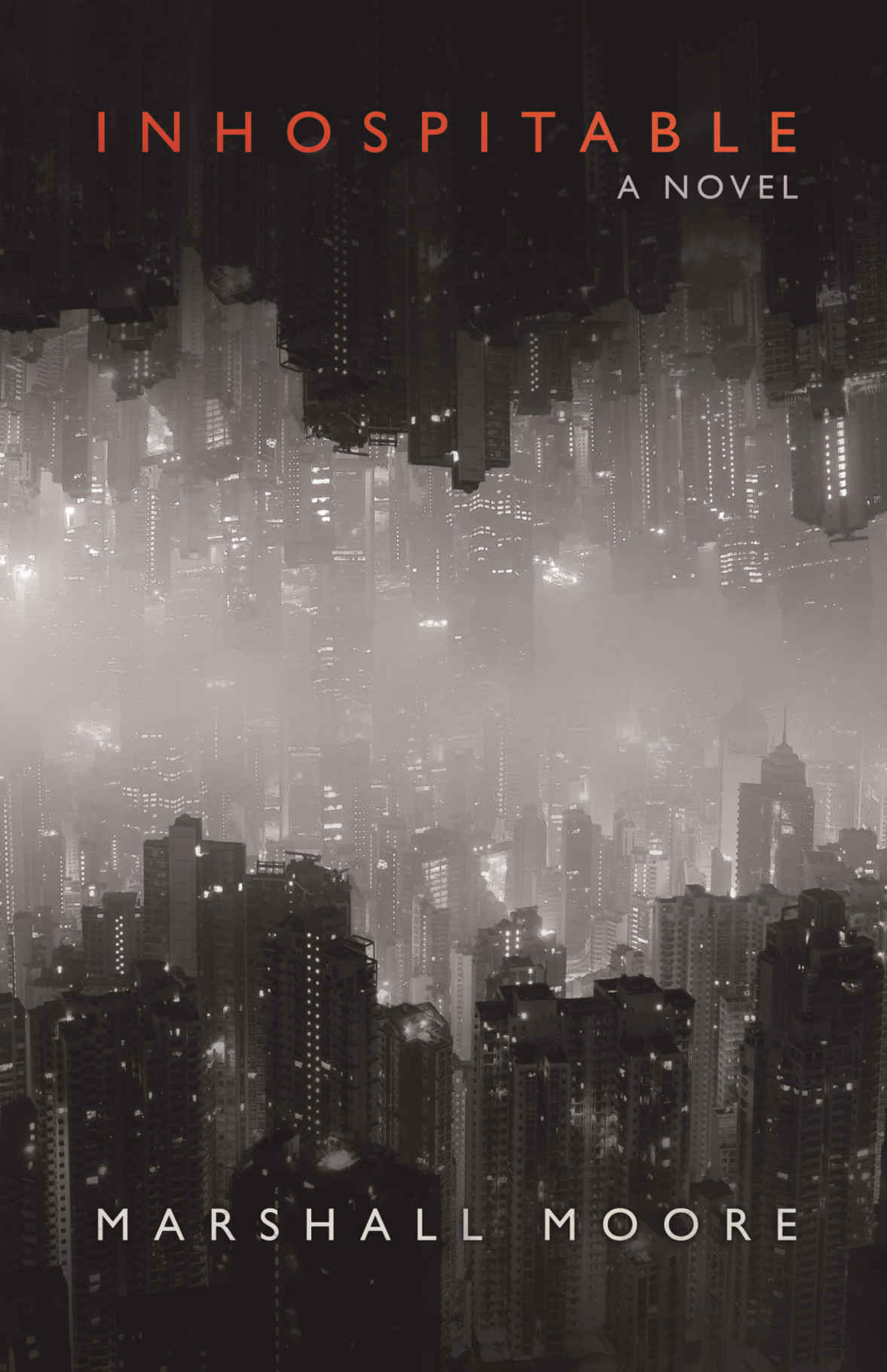 Camphor Press / May 2018
Camphor Press / May 2018
Reviewed by: Vince A. Liaguno
Spooky theatrics, culturally-infused superstitions, conspiratorial wartime collaborations, and even a spectral tribunal fuse to create a ghost story that’s at once as comfortingly familiar as it is wholly unique in Marshall Moore’s first-rate Inhospitable.
Hotel manager Lena Haze leads a comfortably middle-class American life with Marcus, her attorney husband, in North Carolina. When Marcus receives an unexpected inheritance windfall—a mixed-use building in a desirable part of Hong Kong—from an uncle he’s never met, it comes with a caveat: It cannot be sold. With Lena’s background in the hospitality industry, the Haze’s decide to open their dream upscale boutique hotel. Seeking substantial investment for renovations from telecom and real estate tycoons Paul and Jessica Lo, Lena travels ahead to Wan Chai while Marcus closes out their life back in the States. Alone and adjusting to the cultural shock of life in China as a stranger in a strange land, Lena experiences a supernatural encounter—not her first—when she witnesses the seeming suicides of two young people at the outset of the novel. As in any good ghost story, there are no coincidences and the Haze’s soon find themselves in a life and death struggle against a vengeful ghostly presence enacting a decades-old blood feud as their hotel—The Olympia—inches closer to opening.
Moore does an excellent job creating a three-dimensional heroine in Lena, and his supporting cast are no lesser drawn. Of note are Claire, Lena’s newfound fifty-ish friend—herself an expatriate—whose voice is like “rock salt and honey” and who possesses a genteel southern-style sarcasm that drips with a politeness that does little to temper her candor. Isaac, the Lo’s gay son just back from graduate school abroad, is also well-drawn, serving as Lena’s sassy sidekick as the paranormal goings-on ratchet up.
Moore—himself an American expat living in Hong Kong—uses the city not as mere backdrop here but as an essential character. Of particular merit is a scene in which Lena and Isaac traverse into a sketchy area on the outskirts of the city to get more information on the background of their malevolent spirit-villain. Moore uses the idea of the crowd closing in on Lena very effectively, likening it to suffocation. I (like many readers perhaps), having never been to Hong Kong or one of the larger Asian cities, have images from film and TV of throngs of people moving in synchronized determination and Moore deftly captures what it must be like to be caught up in the midst of a moving crowd that large—disoriented, claustrophobic, suffocated. The scene is quite effective and resonates in a visceral way.
Although Inhospitable is sufficiently dark—relentlessly so at times—the novel is not without some wonderful interjections of humor in its scary moments. Consider this brilliantly funny passage from a flashback scene in which a young housekeeper at the North Carolinian hotel Lena formerly managed is fresh from an encounter with the establishment’s resident ghost:
"The next day, one of the housekeepers ran screaming out of 217, having seen the armchair slide across the floor, gaining speed as it approached her. She jumped out of the way at the last second, so it only grazed her, leaving a bruise instead of a fracture. The girl screamed herself hoarse, running down the hall crying and calling out to Jesus for mercy and flailing her hands about and somehow not falling down. Lena heard the ruckus from her office and went running, as did most of the front-line staff. Carlita took the girl (whose name slipped Lena’s mind amid all the uproar) downstairs for tea; Lena and Don reassured alarmed guests that no one had been murdered.
“She just got some bad news,” Lena explained over and over. With older guests, she added the compulsory Southern punctuation: “Bless her heart.”
To a one, they murmured the expected platitudes: “How awful” and “Poor thing” and the like. Lena spent the next twenty minutes piecing together the story. Danae, the seeming target of the armchair, twice interrupted her account of what had happened by breaking into fresh sobs and entreaties to Jesus. Our Lord and Saviour did not put in an appearance, but pharmaceuticals did: Carlita gave Danae half a Xanax and said Christ would want her to relax.
I am so giving you a raise, Lena thought."
With Inhospitable, Moore successfully challenges readers’ longstanding notions of ghosts in a genuinely unnerving tale of the most haunted hotel since King’s Overlook. His deft handling of multi-dimensional, multi-cultural characters creates the requisite emotional investment, while his judicial layering of rich historical detail in between the scares gives added context to this well-plotted, superbly executed work of speculative fiction.
Purchase Inhospitable by Marshall Moore.
Haunted Nights / Edited by Ellen Datlow and Lisa Morton
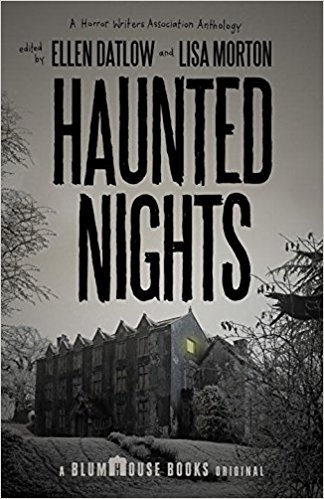 Anchor Books / October 2017
Anchor Books / October 2017
Reviewed by: Vince A. Liaguno
Haunted Nights would seem to have the perfect horror pedigree: It’s co-edited by both the world’s preeminent genre anthologist and the leading authority on Halloween; it’s put together by the world’s largest professional association of horror writers; it’s published by Blumhouse Books, the publishing arm of megawatt horror producer Jason Blum; it boasts a stellar lineup of contributing authors; and it’s got the quintessential horror theme—Halloween.
In her introduction, Morton presents a crash course on the origins—both real-life and literary—of Halloween and makes a compelling case for why the holiday remains so thematically relevant and effective in speculative fiction:
“Halloween, with its roots in a night that lifts the veil between our world and the next, is broad enough to hold horror tropes like ghosts, witches, and shape-shifters, but it also has its own specific icons, like ‘Stingy Jack,’ the blacksmith who outwits the devil but is finally forced to wander the earth forever with his way lit only by a glowing hell ember carried in a carved pumpkin (or turnip), the jack-o’-lantern, in other words. Halloween’s universal appeal—we are all interested in death, aren’t we? —makes it work in both isolated, rural settings and densely packed urban locales. It has a rich history and seems poised to extend into a long and interesting future.”
Morton, sharing co-editing duties with Ellen Datlow, goes on to present sixteen stories cast against their broad Halloween backdrop to demonstrate the holiday’s thematic breadth, depth, and versatility.
This literary Halloween party ably kicks off with Seanan McGuire’s beautifully titled “With Graveyard Weeds and Wolfsbane Seeds.” Her Oregon-set tale tells the story of a lonely ghost girl haunting the halls of her eerily preserved childhood manse in search of a playmate. A group of would-be teenage vandals presents a fine selection from which to choose.
Stephen Graham Jones, always a bankable anthology talent, offers “Dirtmouth.” The first-person confessional format is a smart narrative choice for this story of a grieving widower who—with infant twins in tow for a month-long retreat at a snowy mountain cabin—encounters the simultaneously comforting and discomfiting manifestation of his missing and presumed-dead wife. Jones ably crafts an unreliable narrator who leaves the reader to fill in the blanks and draw conclusions at tale’s end.
Jonathan Maberry presents a mouth-watering revenge tale in “A Small Taste of the Old Country.” An Austrian baker invites two questionably Argentinian men to dine in celebration of Seelenwoche, or All Souls’ week. Maberry’s encyclopedic knowledge of world breads alone is so impressive and immersive that readers will forgive the rather obviousness of the story’s eventual revelations. Try the soul cakes while you’re there!
Ghost stories are the Halloween currency at a dejected roadside tavern in Joanna Parypinski’s atmospheric, if somewhat rushed, “Wick’s End.” Parypinski packs a lot into her modest word count and the result feels like plucking one of those tasty but ultimately disappointingly small sample-size candies out of an otherwise stuffed trick-or-treat bag.
In “The Seventeen-Year Itch,” Garth Nix starts off strong with this escalating tale of a mental hospital and a strange old patient with a nagging itch. Like Parypinski’s tale before it, the reader is left wishing Nix had been sent back by the editors to fill in just a few more of the blanks by story’s end. Instead, like the titular itch, there’s just a nagging sense of missing origin.
A downtrodden single mother of two trying to scrape by on public assistance and living in a bad part of town—especially on Devil’s Night—fears for the man her teenage son will turn out to be in Kate Jonez’s effectively tragic “A Flicker of Light on Devil’s Night.”
Jeffrey Ford dazzles with “Witch Hazel,” a spellbinding tale of 19th-century terror set in the New Jersey Pine Barrens. When twin sisters go on a murderous rampage during a Halloween celebration, the local doctor quickly diagnoses a brain parasite, which he more atmospherically characterizes as “something that has crawled out of the dark heart of the barrens, centuries old.” Dubbed “the suspicions” for “the paranoia it engendered with a fury that took over the mind,” the disease isn’t just a matter of biology and chemistry as the doctor and some of the townsfolk soon find out. Ford nails the feelings of superstitions passed down over generations and the folklore leanings of the story are strong and beautifully executed.
Kelley Armstrong grabs readers in the opening paragraphs of “Nos Galan Gaeaf” and doesn’t let go until the last sentence. She captures both the intricacies of Welsh customs and obsessive-compulsive disorder with a disarming deftness that makes this one of the collection’s standout tales. Bullied teen Lance—or Loser Lance to his detractors—has what appears to be a foolproof plan to rid himself of the girl he’s convinced has bewitched him under cover of his town’s titular calendar designation (also known as Spirit Night) “when the veil between the human world and the otherworld was thinnest.” Armstrong masterfully brings the midwestern town of Cainsville—with its strong Welsh identity and customs—convincingly to life and ghoulishly turns the tables during the rite of Coelcerth, proving that even the most ancient of traditions are rooted in inescapable present-day realities.
While the stories up to this point in Haunted Nights impressively capture either a strong sense of setting or holiday atmosphere, it’s S.P. Miskowski’s “We’re Never Inviting Amber Again” that’s the first to invoke a palpable sense of dread. This deceptively simple tale of a suburban couple’s Halloween party being marred by the appearance of the wife’s sister, who may or may not possess legitimate occult skills, brings the heebie-jeebies in full force. Miskowski uses the invited party guest’s imminent arrival to deftly foreshadow her track record as a party killer and then follows through with the story’s pitch-perfect execution.
In Brian Evenson’s cleverly tongue-in-cheek “Sisters,” Halloween is viewed, explained, and exploited through alien eyes to great comedic effect. The gallows humor is lighthearted and fun here with a decidedly Twilight Zone vibe.
An Irish immigrant, alone and widowed in the New World, must confront folklore-inspired superstitions from the Old World in Elise Forier Edie’s heartrending “All Through the Night.” Another fine example of the myriad elements and emotions that horror can incorporate and explore effectively within the context of genre.
Guilt is the overarching villain in Eric J. Guignard’s fantastical “A Kingdom of Sugar Skulls and Marigolds.” On Día de los Muertos, an L.A. gang member is visited by some deceased loved ones in a bid to help him reconnect with a lost childhood friend to make amends. There’s a surprisingly poignant, left-field twist to this one that Guignard handles nimbly, never sacrificing the authenticity of the machismo gang culture or the lush details of his protagonist’s journey through the magical Mexican holiday. Let this one play out behind the mind’s eye like the literary equivalent of an animated Tim Burton short.
Paul Kane taps into the disquietude we’ve all felt at some point in our lives when we sense someone is standing behind us and we fight the compulsion to turn around in the goosebumps-inducing “The Turn.” Tim Nolan is raised on a steady diet of superstitions and dire warnings about Halloween by his grandmother—superstitions he must confront head-on when circumstances find him out and about on an unexpected Halloween night journey. Kane starts off strong with an unnamed evil narrating and foreshadowing, but he overuses the device to ultimate detraction.
Pat Cadigan offers up her own take on the Stingy Jack legend in the simply-titled “Jack.” A third-generation witch polices the local cemetery on All Soul’s Day awaiting the annual attempt by the titular legend to trick the recently deceased into taking his hellfire turnip lantern off his hands. It’s a solidly atmospheric tale, enhanced considerably by Cadigan’s clever inclusion of some modern-day technology that ably aids her acolyte protagonist.
John Langan submits the strongest—and longest—tale of the Haunted Nights bunch with “Lost in the Dark.” Cinephiles will delight in the meta twists and sheer ingenuity of this layered tale about the possible documentary origins of a popular found-footage horror film. Langan slyly (name)drops Easter eggs (which we’ll refer to here as Halloween candy to keep with the anthology’s theme) with gleeful abandon throughout this thoroughly enjoyable, downright creepy story. Fans of exhaustive documentaries on iconic film franchise villains like Jason Voorhees and Michael Myers will delight in meeting Bad Agatha.
John R. Little’s futuristic “The First Lunar Halloween” scores the enviable—if daunting—task of closing Haunted Nights. Anyone familiar with Little’s work knows he’s a writer up to the task. With Earth destroyed by aliens and surviving mankind living on a moon-based settlement called Tranquility, a school field trip to the lunar surface to recreate the quaint earthy holiday of—you guessed it—Halloween brings intended scares and unintended consequences.
Editors Datlow and Morton and their assemblage of talented Haunted Nights contributors have sixteen opportunities to scare their readers’ pants off. A few—Miskowski and Ford, preeminently—surpass expectations and succeed. A few others, like Edie and Guignard, surprise with their emotional resonance. Others still—Jones, Armstrong, and Langan—bring a refreshing sense of originality to a holiday (at least in the hands of lesser writers) that’s prone to cliché. Haunted Nights succeeds as a whole largely because of the diversity of its parts, a credit to Datlow and Morton in constructing this exemplary anthology.
Purchase Haunted Nights, edited by Ellen Datlow and Lisa Morton.
Goblin / Josh Malerman
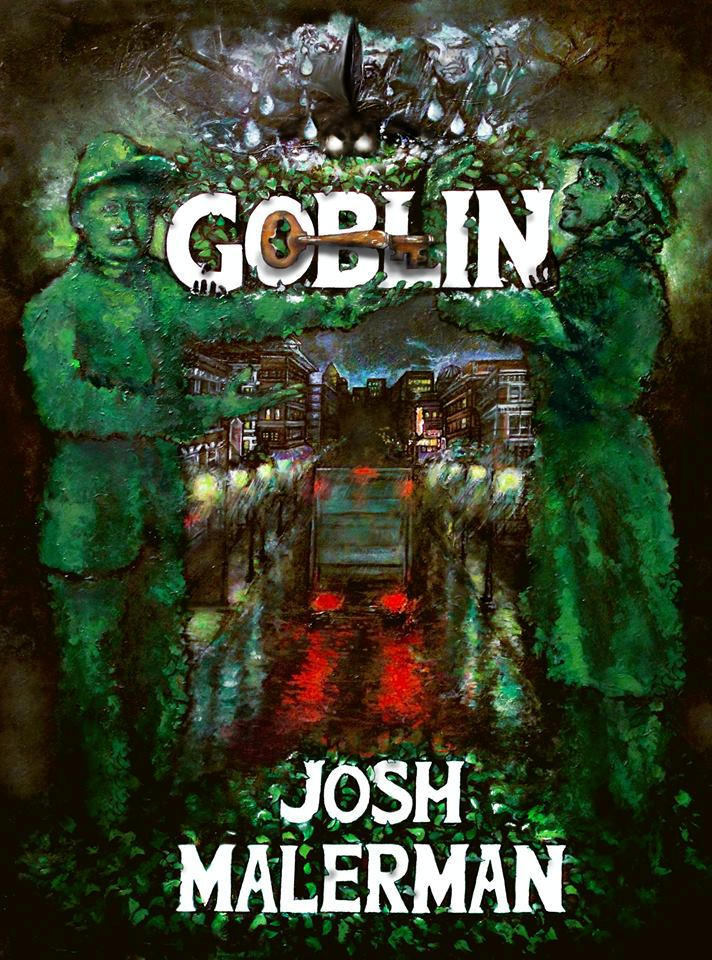 Earthling Publications / October 2017
Earthling Publications / October 2017
Reviewed by: Vince A. Liaguno
It seems like only yesterday when reviewers and readers alike where raising a collective eyebrow in admiration of a new kid on the block named Josh Malerman. DSM has certainly sung the praises of both Bird Box and Black Mad Wheel, a pair of exemplary works of speculative fiction that accurately heralded a major genre talent. These previous novels checked off all the right boxes: original, moody, compelling, tightly-plotted and written.
It’s no surprise then that Goblin, a collection of six novellas that segue masterfully into a full-length novel, will make this three-for-three for Malerman. Reading like a literary equivalent of Michael Dougherty’s modern Halloween classic Trick ‘r Treat fused with Bryan Fuller’s Pushing Daisies and framed within a Creepshow-style anthology narrative, Goblin is Malerman’s bid to universe-build, much in the same way Stephen King has done with Derry, his fictional Maine town that’s served as the setting for novels like It, Bag of Bones, and Dreamcatcher, and been referenced in countless other King works. In Goblin—the town and the book—Malerman constructs a lively topography complete with apocalyptic rains, a cemetery where the dead are buried standing up, haunted woodlands inhabited by a whispering witch and glowing-eyed owls, and a weirdly robotic-alien police force straight out of an unaired episode of The Twilight Zone.
Unlike Bird Box and Black Mad Wheel, which were both decidedly darker and unbearably tense at times, Malerman lets loose a little on Goblin, imbuing each of the six novellas with larger-than-life characters in ghoulishly exaggerated situations. Among the more memorable denizens of the titular Michigan town that readers meet: A lovelorn outcast who mails body parts to the object of his affections; an overworked tour guide who mixes up his places of employment with tragic consequences; a man so terrified of encountering ghosts in his apartment that he rips out all the walls; a little boy enamored of magic and magicians who sneaks out of the house for an ill-fated midnight magic show; a wealthy, egocentric big game hunter whose narcissism is trumped by an unlikely source; and a grieving widower whose intricately-carved topiary maze holds the literal and metaphorical key to release from his sorrow. The six novellas that comprise Goblin are bookended neatly between a prologue and epilogue that tell a seventh story involving an out-of-town truck driver making an unusual delivery in the dead of night that hooks into the town’s rich and bloody history.
Malerman once again shows a singular imagination, conjuring imagery that’s at once familiar and fresh. Whereas Bird Box and Black Mad Wheel used sensory deficit to engage the reader’s own imagination to fill in the descriptive blanks, Malerman seems to reward readers here for all that hard work by laying out a lush, garishly-colored palette of flamboyance and visual excess that’s as vivid as an Argento Blu-ray behind the mind’s eye. It’s all a marvelously fun affair, with stories weaving and intersecting—like an amusement park ride through Le Théâtre du Grand-Guignol. Goblin strikes the perfect balance between its ghastliness and gallows humor, making it both an ideal Halloween destination and a place readers are going to want to visit again.
Purchase Goblin by Josh Malerman.
Black Mad Wheel / Josh Malerman
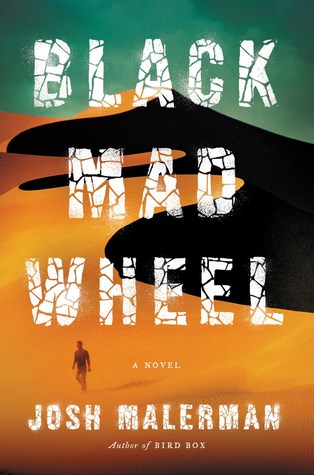 Ecco / May 2017
Ecco / May 2017
Reviewed by: Vince A. Liaguno
Following the widespread acclaim that accompanied his 2014 debut, Bird Box, Josh Malerman had two choices: Follow suit with an equally accessible tale or go outside the (bird) box and craft something entirely dissimilar. With Black Mad Wheel, he opted to do both. The result is a satisfying sophomore effort that feels in some ways more authentic if not as immediately arresting at the outset.
Black Mad Wheel’s authenticity comes from the fact that Malerman merges two real-life worlds he knows intimately—music and fiction. As the frontman of the indie Detroit garage-rock outfit The High Strung, Malerman—the writer—is able to deliver the fictional goods in this story of Philip Tonka, the lead singer and pianist of a fictional Detroit-based rock band called The Danes who wakes up in a seemingly unremarkable Midwestern hospital literally smashed to pieces following the band’s sojourn to an African desert in search of the origin of a mysteriously evil —and powerful—sound. Got that? Yeah, it’s a weird—almost dauntingly ambitious—set-up on the surface, but wise readers who trusted Malerman enough to take them down a river blindfolded should strap themselves in and go along for this ride, too.
Black Mad Wheel rolls out in parallel narratives that move between Philip—with the help of a kindly nurse named Ellen—waking up in the mysterious hospital and slowly piecing together recent events and what happened to him and his bandmates in the Namib Desert. Fascinatingly, Malerman develops a palpable narrative rhythm with these crisp, concise alternating passages that seems to reinforce that—at its heart—Black Mad Wheel is a story about the dueling benevolent and malevolent power of music. The rhythm of the novel picks up as later chapters shorten, building to a feverish intensity in the third act.
Malerman is as comfortable within the novel’s post-WWII setting as he was in the post-apocalyptic landscape he created in Bird Box, proving that he’s no one-trick pony as an architect of setting. And while he throws plenty of weird fiction clichés into his Black Mad Wheel stew—military conspiracies, mad doctors, creepy hospital corridors—his application of such tropes make them feel wholly unique.
If there was one criticism this reviewer could level at the novel, it’s that it feels underdeveloped at times—like it was plucked from its literary branch before it fully ripened. The character of Ellen, for example, and her ensuing romance with the novel’s protagonist, feels rushed, tacked on. As a result, it never quite gains traction for this reader. Likewise, the grand reveal deep in an abandoned diamond mine falls flat. While Malerman toys with and teases some cosmic horror elements, they don’t materialize and the payoff—although it hits the target—misses the bullseye.
With Black Mad Wheel, and Bird Box before it, Malerman has established a new speculative fiction niche—sensory horror—and firmly positioned himself as its maestro. In his previous novel, he explored sight—and its opposite, blindness—and used sensory deprivation to create fear. In Black Mad Wheel, he dissects and deciphers sound, imbuing it with its own distinctive subset of senses and sensations. Here, the horror derives from sensory overload. Sound is kinematic and visualized as geometry of motion—rippling waves of translucence that have heft and vibration. It leaves you wondering which sense Malerman may take on next; just imagine what he could do with taste or smell.
Black Mad Wheel cements Malerman as a strikingly original literary talent. With a weirdly unnerving setup that’s perhaps a notch or two better than the novel’s less inspired payoff, Malerman crafts an absorbing musical analogy of the cyclical nature of war and how history—for all we learn along the converging roads of life—is doomed to repeat itself like an overplayed pop song.
Purchase Black Mad Wheel by Josh Malerman.
Final Girls / Riley Sager
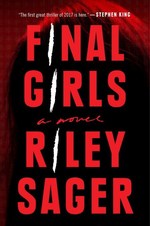 Dutton / July 2017
Dutton / July 2017
Reviewed By: Vince A. Liaguno
It was hard to escape the pre-release buzz for Final Girls, the debut novel of pseudonymous author Riley Sager. As early as December of last year, Stephen King tweet-proclaimed that the book was “the first great thriller of 2017.” And if the King gives something his bloody stamp of approval, it’s got to something special, right? Disappointingly, not so much in the case of Final Girls, a competent-enough, by-the-numbers thriller in which concept outperforms execution.
The set-up is strong and pulls the reader right in: Quincy Carpenter, as sole survivor of a bloody woodlands massacre, is a reluctant member of an elite “club” dubbed Finals Girls by the media. Readers familiar with slasher films will immediately recognize the term, coined by noted film scholar Carol Clover to denote the survivor (almost always female) of said film’s carnage. The other two members of the Final Girls are Lisa Milner, survivor of a sorority house massacre, and Samantha “Sam” Boyd, last girl standing after a mass murderer known as “the Sack Man” butchers staff and guests of a seedy motel. When one of these final girls ends up dead and another on the doorstep of Quincy’s swanky New York City apartment, the mystery begins. Unfortunately, the thrills do not.
While thriller and horror movie fans alike may be drawn to Final Girls initially, the book’s plodding first half may present a challenge to readers. Plagued by interminable passages during which the heroine bakes muffins and cupcakes in between popping Xanax and swigging grape soda, the first half of Sager’s novel seems hell-bent on clobbering readers over the head to reinforce two key points: Quincy may not be the most reliable of narrators and Sam may not be all she seems. What little action the novel’s first half does present shuffles back and forth between late night conversations in Quincy’s Upper West Side apartment and some later-night silliness in Central Park that feels forced and extraneous to the plot. These early proceedings have a YA feel to them, and this reviewer was struck with the idea that the intended audience may be teenage girls more than once. Indeed, a puerile food fight at what should have been a crucial dramatic juncture moving into the book’s third act does little to dispel this feeling.
Thankfully, the novel’s decidedly better-paced second half kicks in with earnest gusto. Although savvy thriller readers will have spotted the novel’s biggest plot twist (there are several of varying merit) early on, Sager does an excellent job ratcheting up the tension and reveals leading up to it as Final Girls enters its third and final act. Sager displays far better command of this more action-oriented thriller portion of the novel and readers will find themselves sucked in again as dread mounts and shocks abound.
Regrettably, the strongest camaraderie Final Girls shares with slasher films is its reliance on convenience (Oh, look…a mental hospital out in the middle of the woods near that isolated cabin!) and people doing illogical things. While there seem so many missed opportunities for winks and nods to fans of slasher movies (who will be drawn to Final Girls), there is a nice subversion of one of the genre’s fundamental playbook rules that’s nicely executed. Think: Cherry Falls.
Books like Final Girls are a peculiar thing. Like films with deafening pre-release buzz, it’s a novel whose enjoyment may be filtered through a lens of greater expectation than it’s capable of delivering. It wears its Gone Girl and The Girl on the Train influences proudly—if not a bit obviously—but readers may be expecting something more. Alas, the only icing to be found in Final Girls is used on the heroine’s cupcakes. Taken as a solid—if slightly formulaic—thriller, Final Girls succeeds. Ultimately, it may prove a case that its eventual movie adaptation will prove better than the source material.
Purchase Final Girls by Riley Sager.
The River at Night / Erica Ferencik
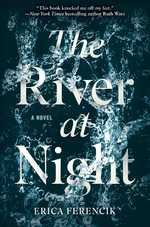 Gallery/Scout Press / January 2017
Gallery/Scout Press / January 2017
Reviewed by: Vince A. Liaguno
Four longtime friends—Winifred, Pia, Rachel, and Sandra—embark on what’s supposed to be a rejuvenating hiking and rafting excursion through Maine’s desolate Allagash Wilderness. What could possibly go wrong, right?
Anyone who is familiar with well-tread thriller and horror tropes will be able to spot the set-up from a mile away, but what sets Ferencik’s danger-in-the-woods novel apart from similar tales is her relentless, breakneck pacing. It’s a fast-paced 304 pages that whips the reader to and fro, jostling with its unpredictable plot twists and breathtaking tempo.
Ferencik ably establishes her four leads early on so that their bond—even when the complexities of adulthood threaten its stability at times—is believably strong enough to be their greatest defense once the proverbial shit hits the fan. And hit the fan it does. In the aftermath of what appears at first to be a freak rafting accident that leaves the women stranded, separated from both their raft and supplies, they glimpse a fire burning on the mountainside. This leads them to a ramshackle camp and what appears to be their lifeline. Suffice to say—so as not to give too much of the plot away—it’s not.
The River at Night will immediately call to mind images of wilderness survival films like (most obviously) The River Wild with dashes of Deliverance and Wrong Turn layered in to keep the proceedings appropriately foreboding and, ultimately, bloodcurdling. The scares merge with the adventure elements of Ferencik’s story, imbuing it with a white-knuckle tension that’s the literary equivalent of a spiraling whitewater rafting ride down the rapids. Ferencik’s prose—while economical—is visceral and lush, adding a satisfying literary feel that never detracts from the high-octane action.
Ferencik is to be commended for the balance she strikes between plot and character. While The River at Night is an adventure story at its core, it also delves into the larger ruminations of women at the crossroads of midlife. At the story’s onset, each of the women embark upon their trip carrying metaphorical baggage with them—addiction, abusive relationships, grief, illness, and loneliness. But the dire circumstances they soon find themselves it cause them to emblematically shed those weighty inner burdens, summoning their individual and collective strength to survive and overcome the extreme physical threats they’re faced with. One of those threats—the raging river and savage terrain of the surrounding wilderness—becomes a central character itself under Ferencik’s steady, guiding hand. And, like all well-crafted characters, it slowly reveals itself—idyllic and serene at first glance but with an unrelenting, raw brutality lurking underneath its verdure on closer inspection.
The River at Night is the quintessential page-turner and highly recommended reading material for those summertime camping trips. With relatable, well-drawn characters and a high-speed narrative that may leave you breathless at points, Ferencik’s cinematic novel may have you fantasy casting Wini, Pia, Rachel, and Sandra long into the night as this reviewer did.
Purchase The River at Night by Erica Ferencik.
The Devil Crept In / Ania Ahlborn
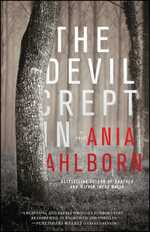 Gallery Books / February 2017
Gallery Books / February 2017
Reviewed by: Vince A. Liaguno
The missing child is a frequently used narrative spark in the domains of horror fiction and thrillers. In the hands of lesser writers, it runs the risk of cliché and cheap imitation. Luckily for readers, Ania Ahlborn is not one of those writers.
The Devil Crept In is the Polish-born dark scribe’s eighth novel, a straightforward tale of horror peppered with thriller elements that’s sure to please readers partial to either genre. The story delves right in, beginning with the disappearance of rebellious preteen Jude Brighton, cousin and best friend to the novel’s protagonist, ten-year-old Stevie Clark. Stevie is a gutsy and brilliant choice to be the main voice of Ahlborn’s novel; his verbal tics, clanging, and hallucinations indicating an undiagnosed schizophrenia make him both the quintessential unreliable narrator and a most sympathetic protagonist. He’s the ultimate outsider. More to Ahlborn’s credit is that she’s able to realistically portray young Stevie’s vocal outbursts and repetition without pulling the reader out of her engrossing story.
There are dual narratives running through The Devil Crept In – one present day, the other flashback – and a wonderful undertone of urban legend at work here that compliments the mood Ahlborn sets early on. To give away much more of the plot would be a disservice to the reader, especially since Ahlborn keeps her storytelling tight with no subplots to speak of. Ahlborn’s pacing is solid, yet the story unfolds slowly, which may surprise readers at the end when they realize that they’ve traveled 374 pages along a relatively straight-line continuum. Fortunately, the flashback storyline that provides the origin story for present day events, feels more action-oriented and compliments the slower burn of the main narrative thread.
What really elevates The Devil Crept In is the emotional resonance at its core. While the story appears to be about a boy and his exhaustive quest to find out what happened to his best friend, it really speaks more to the unbreakable bonds between mothers and sons, especially in the face of challenging disabilities – from mental and social disorders to birth defects (exaggerated to horrific levels as they may be here). Ahlborn lays her thematic substance in subtly so that it never clobbers readers over the head or detracts from the horror at hand; instead, there’s a delicate sense of maternal melancholy that saturates beautifully-written passages sandwiched between the more chilling plot turns. Thankfully, the trio of mother-son relationships at the center of the novel ably compensate for Ahlborn’s misfire with an abusive stepfather figure who’s more cardboard cutout than credible character.
Ahlborn is a writer of considerable skill and imagination – both of which are on fine display in The Devil Crept In. She maximizes her tried-and-true dark woods setting, infusing a palpable sense of supernatural dread. The novel is ripe with genuinely creepy, sometimes downright gory imagery, but it’s infused with an uncanny sense of coming-of-age and rites of passage, with scenes calling to mind King’s Pet Semetary and even the film Fright Night. She even manages to pack one wallop of a goosebumps-inducing twist into her very effective epilogue that will leave readers wanting more – the way all great novels should.
Purchase The Devil Crept In by Ania Ahlborn.




